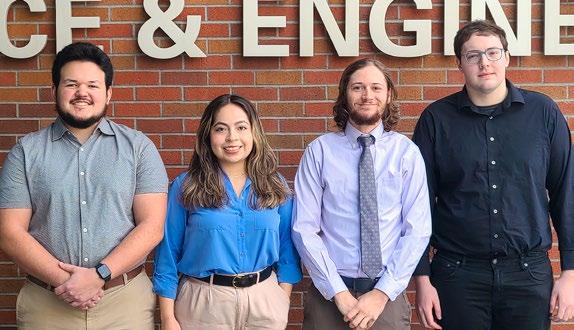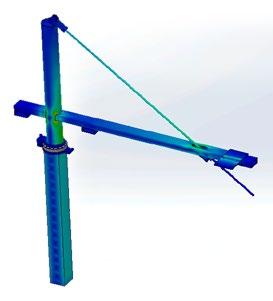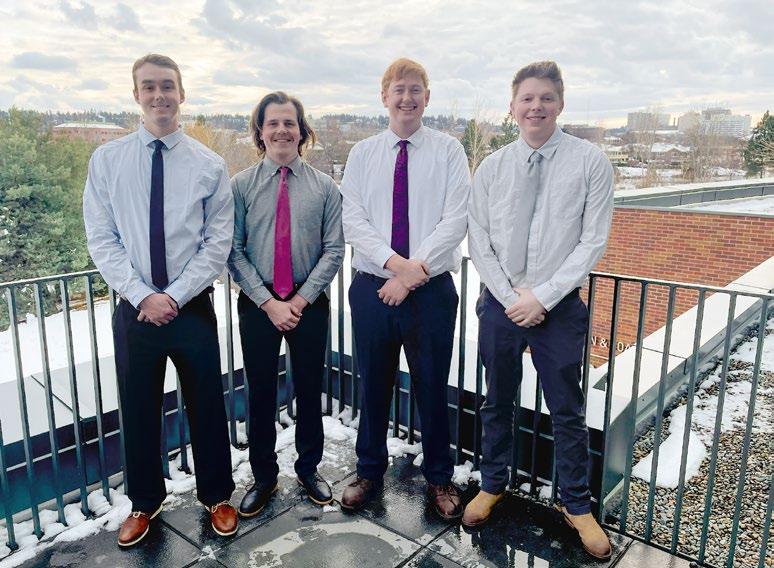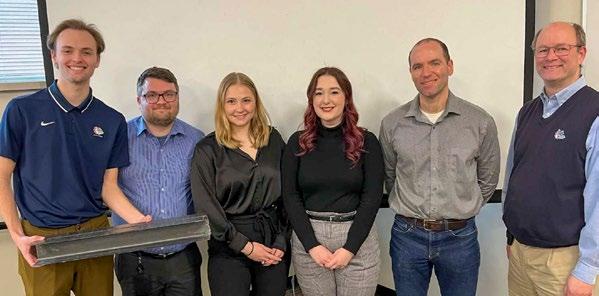
3 minute read
ENSC-60 | Document Lift System


» Michael Ashe, Electrical Engineering
» Diana Garcia Diaz, Electrical Engineering
» Alexander Jones, Mechanical Engineering
» Andrew Wilson, Mechanical Engineering
ADVISOR: Shane Pacini

DAB: Alek Marinos, Terra Donley
SPONSOR: Transitions (help4women.org)
LIAISON: Edie Rice-Sauer, Randy Brown
Transitions, an organization which addresses women’s poverty and homelessness, built a fire-safe room in the basement of their main facility to store required records and documents. Using the stairs to move file boxes to the basement posed a potential safety hazard and challenge to their employees. ENSC-60 was tasked with designing and prototyping a lift system to move the boxes containing the documents safely to the basement. The team developed a lift design and analysis package of the loads and electrical components. The designed lift system is composed of three segments for ease of integration on-site and sub-scale testing. A prototype was designed, built, and tested using one of the three segments to validate the selected components and verify the lift system operates safely. The team submitted assembly drawings, a structural analysis report, wiring schematics, a user manual, and an installation guide.
ENSC-61 | Roll Table Polishing Sled
» Andrew Breemer, Mechanical Engineering
» Chase McSweeney, Mechanical Engineering
» Matthew Mikita, Mechanical Engineering
» McCallister Wahl, Mechanical Engineering
ADVISOR: Colleen Nolting
DAB: Bob Reed
SPONSOR: Kaiser Aluminum
LIAISON: Colleen Nolting
During the production of aluminum plates, slabs of aluminum are reduced to the desired thickness using several rolling mills. The slabs are transported between mills on powered roll tables. Over time these powered rollers develop aluminum buildup and surface imperfections from the aluminum slabs. To prevent this, Kaiser Aluminum polishes the rollers using a sled that presses sandpaper against the rollers while they are being operated. The sled was previously held in place using an overhead crane, resulting in an unfavorable loading condition on the crane, and contributed to lower downtime efficiency. To correct this problem, ENSC-61 has developed a jib crane deployment system for the polishing sled. The deployment system is designed to be portable throughout the Kaiser Aluminum facility by allowing it to be slotted into inset pockets in the concrete at points alongside the transport tables.
ENSC-62 | Aluminum Casting Tap Block Puller
The ENSC-62 team worked with Kaiser Aluminum to address safety concerns surrounding the removal of tap blocks from their furnaces. The tap block, a ceramic block with a tunnel through it to control the flow of molten aluminum between production stations, is currently removed through manual or robotic jackhammering. This method has potential to cause injuries such as sprains, strains, and exposure to flying debris. ENSC-62 developed a new removal process utilizing a titanium sleeve with pre-tapped threads to surround the tap block. When the tap block needs to be removed, eyebolts can be threaded into the sleeve and steel cables routed through the eyebolts. A pulling device using a hydraulic cylinder can then break the tap block free, and a crane can finish safely removing it.
» Alexander Babij, Mechanical Engineering
» Gabriel Barahona Rapalo, Mechanical Eng.
» William Bays, Mechanical Engineering
» Murad Hummatov, Mechanical Engineering
ADVISOR: Chris Nicol
DAB: Justin Chin
SPONSOR: Kaiser Aluminum
LIAISON: Chris Nicol
ENSC-63 | SAMPE Student Bridge Competition
» Andreas Andersson, Mechanical Engineering
» Connor Lotzkar, Mechanical Engineering
» Claire Powell, Eng. Management (Mechanical)
» Aubrey Scott, Mechanical Engineering
ADVISOR: Rudy Lauth
DAB: Gary Weber
SPONSOR: Student proposed, Materials Advantage Club



LIAISON: Scott Aubrey, Andreas Andersson
ENSC-63 utilized the Society for the Advancement of Material and Process Engineering’s (SAMPE) Student Bridge Competition to explore topics in composite manufacturing, material properties, and different geometric behavior in I-beams. The team analyzed a concept for an I-beam that would have an inner web following a trapezoidal shape rather than the straight line geometry found in a typical I-beam. This uniquely shaped beam provided potential to create an I-beam that could withstand greater loads during a three-point bend test and granted the team the ability to explore different fabrication processes. With this information, the team developed and manufactured a tooling concept that would allow for a repeatable fabrication process of a trapezoidal shape. ENSC-63 utilized a lay-up process in order to produce I-beams that could be tested, analyzed, and improved in iterative fabrication processes. The team competed in the SAMPE competition and developed a poster to display results.











